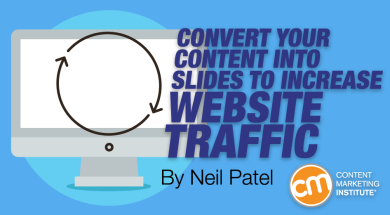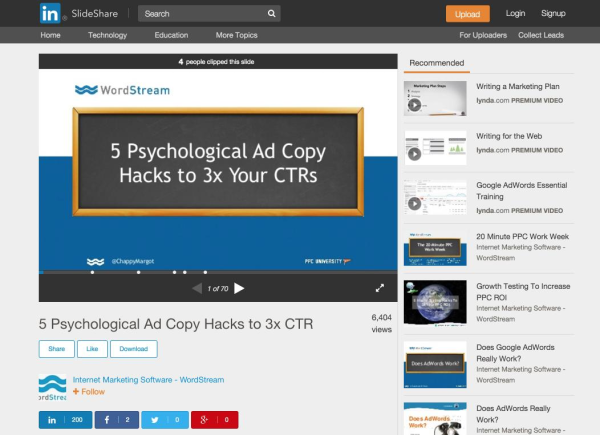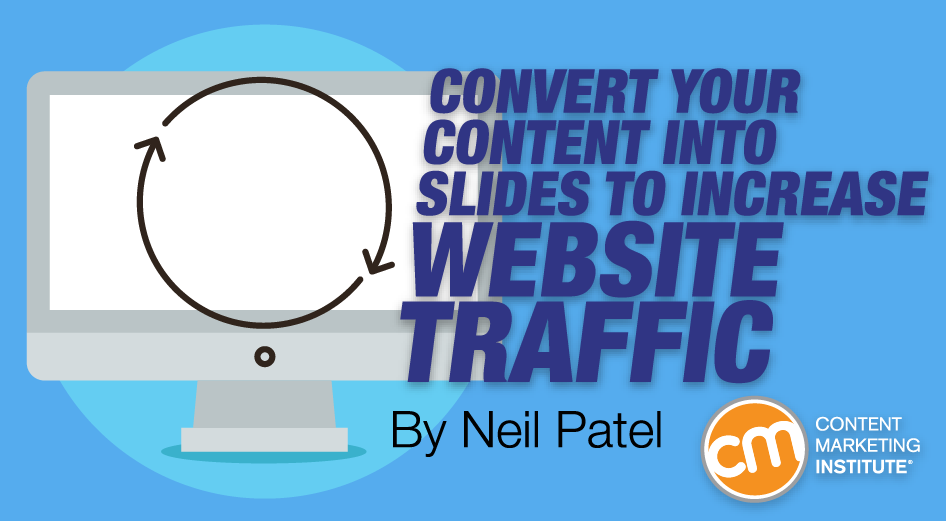
With so many kinds of content marketing, how do you choose the best methods? In my opinion, the more content methods you use, the better.
Why? Because more methods mean more traffic.
One of those powerful methods is slides. Using slides is such a strong method because you can virtually double or triple your level of traffic with only half the work. Plus, you reach an audience that is focused, engaged, and likely to convert.
SlideShare Secrets to Stack the Decks in Your Favor
What does it mean to convert your articles into slides?
What do I mean by converting articles into slides? First, let me be clear about slides.
Nearly everyone in the business world has seen or created PowerPoint or Keynote presentations. PowerPoint presentations are so commonplace and notoriously boring that the term “death by PowerPoint” is a thing.
Plenty of people know that PowerPoint errors persist, and try to correct the problem.
Even though people may make fun of PowerPoint and say that it is boring, they still use slides, read slides, and benefit from slide presentations.
The world’s highest-traffic slide presentation site is SlideShare.

LinkedIn’s SlideShare is basically a slide-sharing service. The platform allows users to upload and share their slide decks (PowerPoint, PDF, Keynote, or OpenDocument).
SlideShare is a content marketer’s dream come true. Here’s why:
- SlideShare generates targeted leads.
- There are 70 million SlideShare users.
- Eighty percent of SlideShare visitors come through targeted search.
- SlideShare has a page authority of 79 and a domain authority of 95. In other words, it has killer SEO.
- SlideShare has content from the world’s leading authorities on specific subject matter.
- SlideShare has 7 million slide presentations.
- There are 400,000 presentations uploaded to SlideShare each month.
- SlideShare also hosts text content, videos, and infographics.
- SlideShare presentations have a higher effectiveness rate than white papers.
Obviously, there are a lot of benefits to using SlideShare. Yet, many marketers who use the platform do so only occasionally. This is a problem because the real benefits of SlideShare build up as you add more content.
Converting your articles into slides is as simple as turning a blog article into a slide format. Let me show you an example:
WordStream published this great article, 5 Psychological Tricks to Exploit in Your PPC Ad Copy, by Margot da Cunha on July 20, 2015.

It’s a strong long-form piece of content from a recognized authority. The article has images and plenty of helpful advice.
Now, take a look at this:

Does it look familiar?
It’s a SlideShare presentation – 5 Psychological Ad Copy Hacks to 3x CTR – authored by Margot and uploaded by WordStream on Dec. 10, 2015.
The idea of the content is the same – theme, data, points, etc. The format is different.
For example, her SlideShare point states, “Spark Engagement through FOMO, Rewards, & Uncertainty.”

But her article states, “Appeal to the I-Don’t-Want-to-Be-Left-Out Fear.”
Same idea. Same basic concept.
Two different platforms.
Margot was smart. Not only did she use this content on a blog and SlideShare, but she also used it in a webinar. Triple repurposing!
That is the basic idea. You take a great article that you produced on your blog, place the content into a slide presentation, and upload to SlideShare.
How do slides fit in with a content marketing strategy?
According to CMI’s definition, “Content marketing is a strategic marketing approach focused on creating and distributing valuable, relevant, and consistent content to attract and retain a clearly-defined audience – and, ultimately, to drive profitable customer action.”
Following this definition, SlideShare features some of the most powerful content available. Spend a few minutes browsing SlideShare, and you’ll discover the following:
- Valuable content
- Relevant content
- Consistent publishers
- Attractive content
- Targeted audience
- Conversion-focused content
One of the most common misconceptions about content marketing is the idea that it has to include blogging. Blogging is, of course, a really valuable form of content, but it’s not the only one.
In fact, some brands are excellent content marketers without a blog.
How does this work? Effective content marketing starts with identifying your target audience and understanding how they access content.
SlideShare has an audience of highly engaged users, many of whom are professionals on LinkedIn. The SEO authority of SlideShare’s site means that content featured on SlideShare is likely to have SEO value. The content itself is presented in a format that is easy to read and digest.
The bottom line is this: SlideShare is an excellent component of any content marketing strategy. If you’re producing blog or article content anyway, then turning it into slides is an obvious move. You’ll receive more and better traffic.
Why you should turn articles into slides
Besides more and better traffic, what other reasons are there to turn articles into slides? Here are some:
- It’s easy. You’ve already done the exhausting brainwork of research, writing, development, and explanation.
- It’s fast. It’s easy to waste time making slide presentations from scratch. If you have a presentation template and some handy images, it doesn’t take too long to place your article into a slide presentation.
- It has a high ROI. Considering the time that you spend flipping an article into a presentation, you’re getting a massive return on your investment.
- It produces traffic from a different source. SlideShare visitors may not be familiar with your brand or product. Delivering content via SlideShare is a great way to access new sources of traffic.
- It offers searchable discovery. SlideShare users often search for their preferred topic using SlideShare’s search bar or categories. The content they see is the content they want. The advantage for you is targeted and relevant traffic.
How do you do it?
I hope you’re convinced of the “should-I” reasons for conversion. Now, here are a few “how-do-I” pointers.
Obviously, SlideShare is a different platform with a different content model. Your ideas remain, but your format will change.
- Adapt your outline into stand-alone points. Your article likely has an outline. Make sure that your outline is clear and can serve as a logical structure for your presentation.
- Use one slide to feature your main point.
- Use the next slides to develop your main point.
- Make sure that each slide includes only one idea. Try not to use a lot of bullet points.
- Use attractive images. Some designers favor a full-screen image for each slide. You might not have the time or resources to do so, which is fine.
- Use a lot of slides – it’s OK.
- Include a call to action at the end of your slideshow.
Let me share an example. If you wrote an article about the rise of mobile communication, one of your main headlines might be something like this: “Beyond Texting.”
Within this point, you discuss six types of mobile communication other than texting. You have six sub-points – voice, images, videos, money transfer, dating, and image recognition.
This outline works perfectly for a SlideShare presentation:
Main point: Beyond Texting

This main slide includes a preview of the upcoming six sub-points.
Sub-point: Voice

The Voice sub-point slide is image-intensive. The only text is a single sentence about the voice functionality of four popular mobile apps. The images reinforce the point.
Sub-point: Images

This second sub-point uses a lot of color and imagery. The slide communicates the large number of users and information shared via Snapchat. While the slide could have been adapted from a full paragraph in an article, it contains only 19 words.
The full presentation is 29 slides. The seven main points are coherent and focused. The slides that follow are image-rich and data-driven. It’s a compelling and focused presentation.
And here’s the great thing. You can create all kinds of presentations from all kinds of articles. In fact, if you want, you can create several presentations from a single article.
Of course, not every article can be so easily converted to a presentation. For example, the articles that I write on Quicksprout and NeilPatel.com are usually between 1,500 and 4,000 words. These are tactical, how-to posts with detailed instructions on executing content and SEO strategies. The nature of those posts does not lend itself well to a presentation format.
Conclusion
With a bit of creative thinking and some familiarity with SlideShare, you can unleash a whole new component to your content marketing strategy. The more content tactics that you can understand, use, and master, the more effective your content marketing becomes.
As you continually refine, streamline, and improve your content, you will grow into an unstoppable marketing force. Converting blog articles into slides is one such way to augment your content marketing strategy, showcase your thought leadership, and drive tons of fresh traffic to your website.
11 Killer Tips to Leverage SlideShare’s Power in Your Visual Content Marketing
Have you tried converting blog articles into SlideShare presentations? What do you think?
Ready to convert to an email subscriber at the Content Marketing Institute for daily or weekly insight to help you improve your content marketing success? Sign up today.
Cover image by Joseph Kalinowski/Content Marketing Institute

